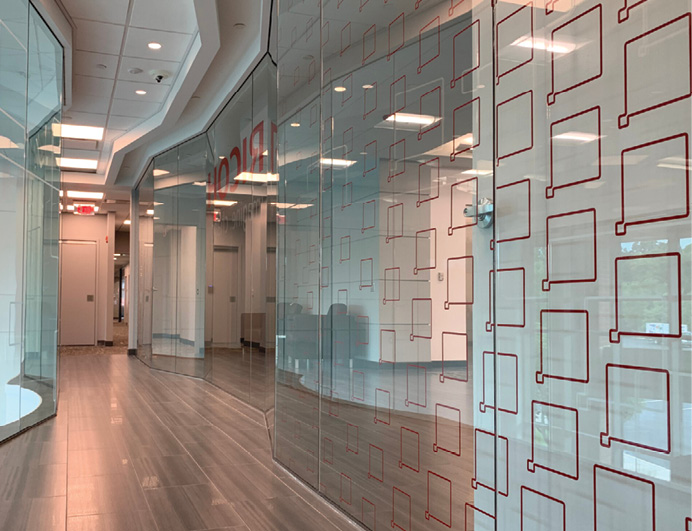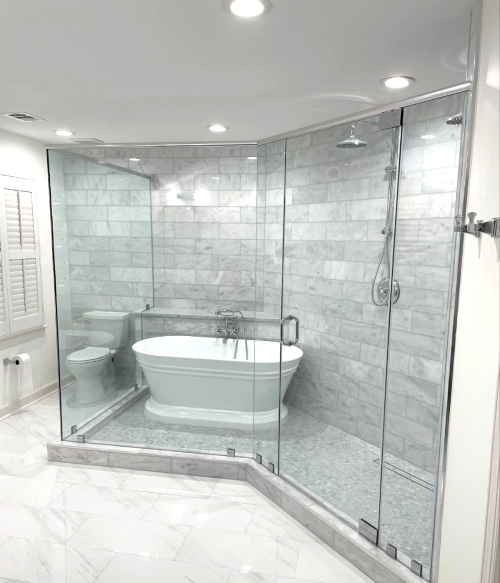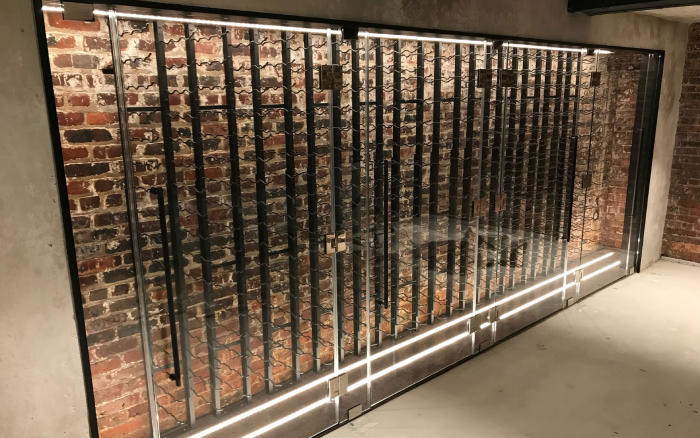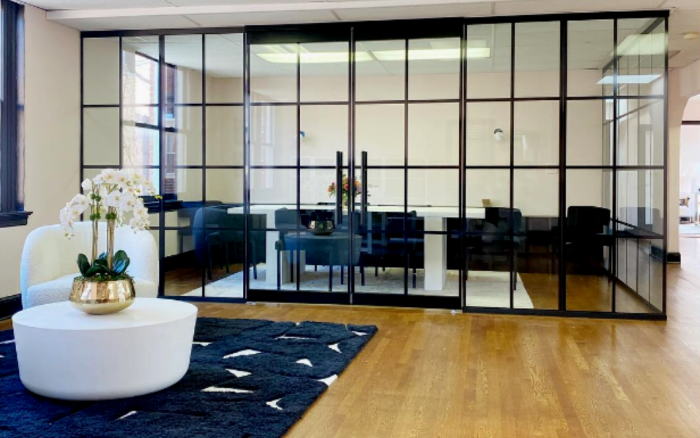Eye on Interiors
How designers look to glass for flexible workspaces, stylish home interiors

Above: Glass wall system installation. Photo by Transwall
The pandemic left us with a greater appreciation for where we spend most of our time—our homes. The past few years have seen an increased focus on maximizing and upgrading our living space. This continues into the new year with an emphasis on luxurious bathrooms, wine rooms, closets and cellars.
Today’s workplace is following suit with an increased emphasis on designing for wellness. These ideological shifts are reflected in the way both work and residential spaces are utilized.
Luxury primary baths

Home has always been important but now, more than ever, there is a greater emphasis on it as a place for relaxation, leisure or entertainment.
Take the primary bathroom, which continues to grow in size in everything from single-family homes to luxury condominiums. Now, we’re seeing an emphasis on all-inclusive wet rooms—totally waterproofed bathrooms with curb-less showers and freestanding tubs. These began as a solution for smaller spaces, but are gaining popularity as they create a more spacious aesthetic.
The heightened focus on primary bathrooms has resulted in a greater demand for large glass shower enclosures. These can be hinged, sliding, or fixed panels. Some run up to the ceiling with a vent panel for the option of a steam or shower enclosure.
Homeowners understand that a premium investment upfront will prevent the need to replace lower-quality glass down the line. The ease of cleaning and maintenance ensures the glass will look and perform optimally longer than traditional tile, ceramic, or stone. Even better, there are multiple options for single-surface, shower-protected glass or dual-surface glass protection. Contractors have the flexibility to offer what best meets customer needs.
Finally, the broader use of walls and doors provide designers the opportunity to make striking visual statements with back-painted glass or custom wall cladding.
Trends we were watching at the end of last year continue to gain traction. Namely, iron grids and black matte finishes in both residential and commercial applications. You’ll find direct-to-glass printed grid designs on showers, but also on interior glass walls and office partitions.
Wine cellars, glass railings

Reimagining the home interior creates the opportunity to put other existing spaces to better use. Closets under the stairs and bonus rooms are being transformed into stylish wine cellars that can be exquisitely showcased with floor to ceiling glass enclosures.
Openness is the deciding trend, one easily captured by creating more visual space with glass walls and glass railings. Even though the square footage remains the same, glass provides the feel of more room, and therein, more value.
In realizing these designs, glass continues to be a creative and flexible material for commercial interior designers and homeowners. It’s easier to maintain and clean than traditional alternatives—and more cost effective since glass can be fabricated to mimic anything from stone and marble to wood. There are numerous possibilities for maximizing space and adding personality with back-painted and direct-to-glass backsplashes and wall cladding.
Glass railings have always been popular for commercial building designs, but now we are seeing more and more glass railing designs being used for residential applications—interior and exterior. Not unlike the trend for frameless heavy glass shower enclosures, designers want glass railings with little or no exposed hardware, even to the exclusion of a top cap.
Flexible workspaces

Today’s employees believe the top three primary purposes of the workplace are collaboration with teams, building social connections and camaraderie, and developing personal and professional relationships. As such, offices are being designed to accommodate flexible workspaces and meeting areas. And when it comes to daylighting—the emphasis on health and wellness isn’t going anywhere.
For the glass industry, this means an increased demand for demountable partitions—movable, sliding, and folding glass walls and glass wall systems.
Designers and architects can answer this growing need with movable glass partition walls that are easily reconfigured into meeting spaces. Likewise, open areas with ample daylighting and functional areas with multipurpose use—think walls that double as glass markerboards for idea sharing and collaboration—combine durability and flexibility with a minimal and clean design.
The workforce became accustomed to an elevated level of privacy while operating from home. Varying levels of privacy are easily achievable with satin etched, textured patterned, direct-to-glass printing and dynamic glazing—to maximize employee comfort and confidentiality. Laminated glass takes this a step further with sound-reducing interlayers and privacy fades.
A lot has shaped the way both work and home spaces are regarded and utilized over the last few years. Glass continues to prove itself versatile and uniquely equipped to fulfill a range of creative, practical and aesthetic demands.


